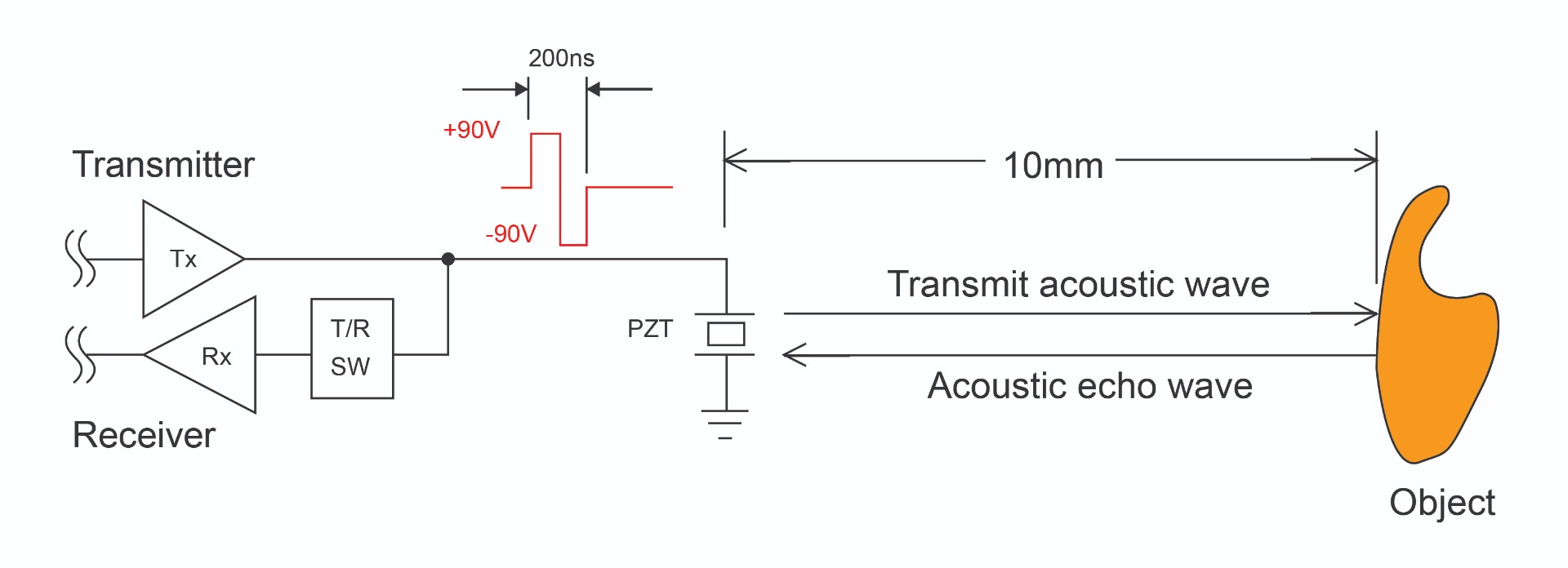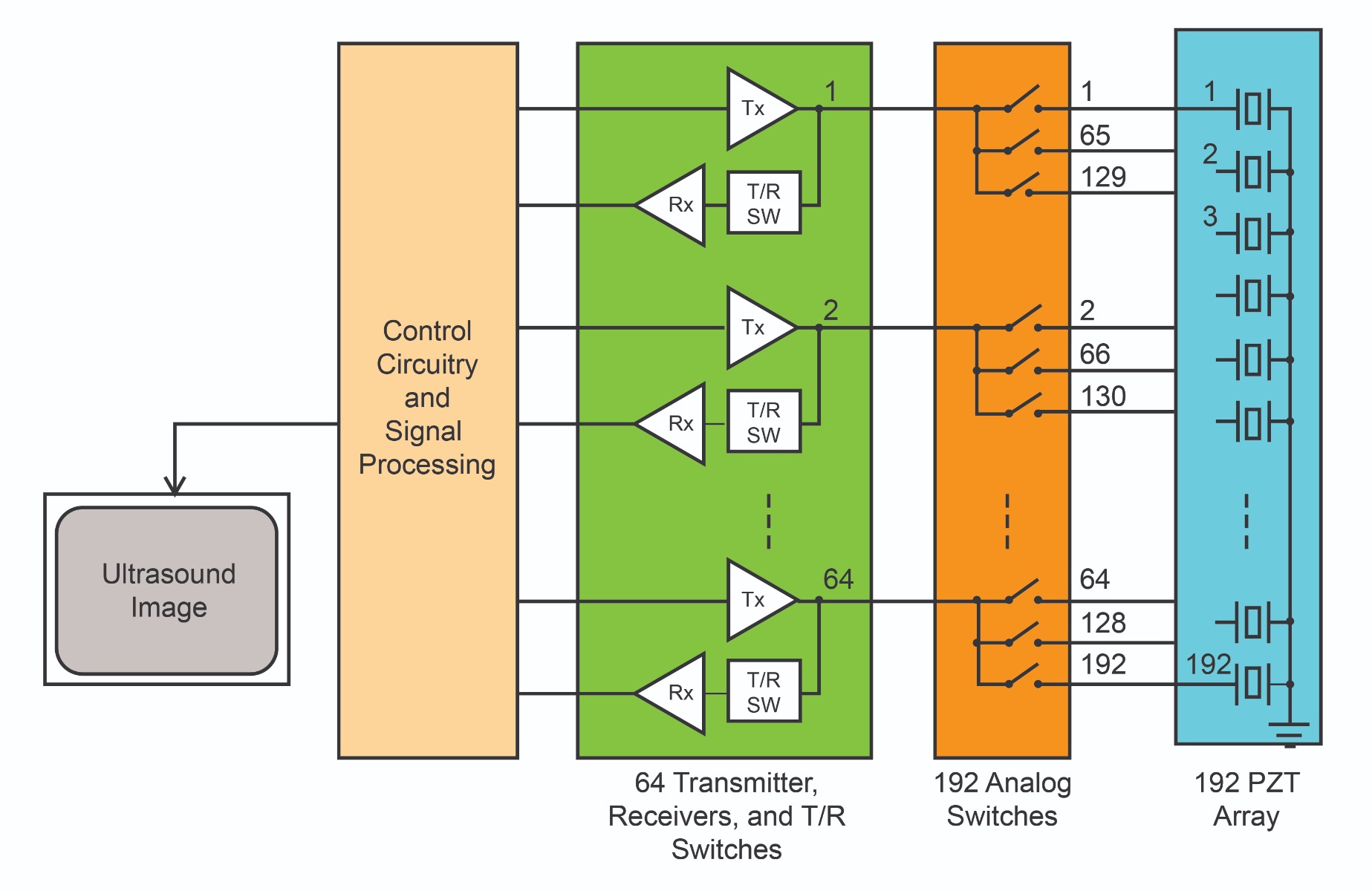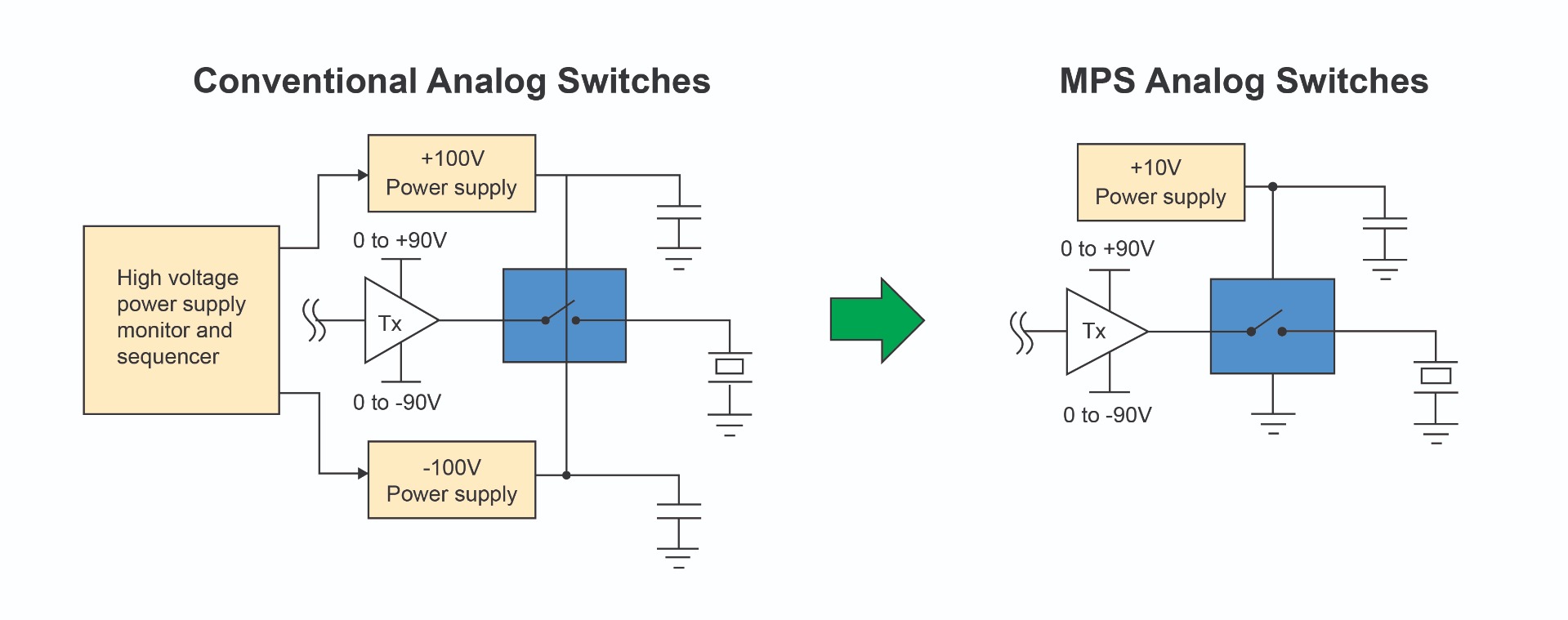High-Voltage Analog Switches for Medical Ultrasound
by Jimes Lei, Technical Director, Applications Ultrasound, Automotive & Industrial Products, Monolithic Power Systems, Inc.
Basic Principle of Medical Ultrasound Imaging
Medical ultrasound imaging is a non-invasive method of viewing internal organs and structures of the human body using high-frequency acoustic waves. By sending an acoustic wave into the human body and listening to the acoustic echoes, an ultrasound image can be created. Given the acoustic properties of the human body, the optimum frequency range for general medical ultrasound imaging is 1.0MHz to 12.0MHz.
创建声波,压电反式ducer (PZT) is used. The PZT physically expands and contracts when a voltage is applied to it, thereby converting electrical energy into acoustic energy. High-voltage pulses are used to excite the PZT. A pulse generator, sometimes referred to as the transmitter, with amplitudes of up to ±90V and current capability of ±2.0A are used. The same PZT is used to convert acoustic echoes back into electrical signals, which are referred to as the receive signals. The received signals are processed and analyzed to construct an ultrasound image of the transmitted path.
To better understand the principle of operation, consider a single-channel PZT (see Figure 1). During the transmit cycle, a single 5MHz cycle of ±90V is generated from the transmitter and applied across the PZT. The PZT creates a 5MHz acoustic wave that travels into the body, and the receiver starts listening for echoes. Acoustic waves travel on the average of 1.54mm/μs within the human body. To create an image of an object that is 10mm away from the PZT, a time duration of 10mm / (1.54mm/μs) = 6.49μs is required for the acoustic transmit wave to reach the object. Another 6.49μs of time is needed for the acoustic echo to reach the PZT from the object. The signal received at 12.98μs corresponds to an object 10mm away from the PZT. The time duration for the received cycle is therefore longer when imaging objects further away from the PZT. Once all echoes are received, one line of image can be constructed.

Figure 1: Single-Channel PZT Example
The receiver is a high-performance, low-noise, low-voltage device that can be easily damaged if the high-voltage pulses from the transmitter are applied to its input. Figure 1 shows a T/R SW block which denotes a transmit/receive switch used to block the high-voltage transmit pulse but allows the low-voltage receive signal to pass into the receiver’s input. The receive voltage is typically less than ±500mV.
To create a two-dimensional image, an array of PZTs is needed. An ultrasound probe is used to house the array of PZTs. There are many different types of ultrasound probes, such as abdominal, cardiac, and pediatric probes, among others, and are all specifically designed for various applications. The number of PZTs can vary depending on the probe type ranging from 128 PZTs to 512 PZTs. An array of 192 PZTs will be used as an example for this article.
使用高压Analog Switches
Figure 2 shows a basic medical ultrasound system driving an ultrasound probe with 192 PZTs. High-voltage analog switches are used to multiplex the transmitter, receiver, and T/R switch set to different PZTs.

Figure 2: Medical Ultrasound System Diagram
In the example in Figure 2, there are 64 sets of transmitters, receivers, and T/R switches. Each set drives three PZT elements. There are 192 high-voltageanalog switchesarranged in such a way that groups of 64 PZT elements are being driven. The analog switches route the 64 sets of transmitters, receivers, and T/R switches to drive PZT 1 to 64. The 64 transmitters send high voltage pulses into PZT 1 to 64. The system waits until all echoes from PZT 1 to 64 are received. For the next cycle, the analog switches reroute the 64 sets of transmitters, receivers, and T/R switches to drive PZT 2 to 65. The 64 transmitters send high-voltage pulses into PZT 2 to 65, and the system waits to receive all echoes from PZT 2 to 65. This routine of transmitting, receiving, and rerouting repeats with the analog switches rerouting the transmitters, receivers, and T/R switches by one PZT increment at a time. Once all 192 cycles are completed, one frame of image can be constructed in about 50ms.
Without the use of high-voltage analog switches, 192 transmitters, receivers, and T/R switches are required to drive the 192 PZTs. With the use of high-voltage analog switches, the number of transmitter, receivers, and T/R switches is reduced by a factor of three, saving cost, power, and size.
Advantages and Benefits of MPS High-Voltage Analog Switches
Figure 3 shows the basic differences of using conventional analog switches versusMPS analog switches。传统的高压模拟开关ICs require two high-voltage power supplies, +100V and -100V, for proper operation. The high-voltage pulses going through the analog switch must be within 10V of the high-voltage supplies. For ±100V supplies, the maximum transmit voltage is ±90V. Additional circuits are needed to generate these two high-voltage supplies, as they are not needed elsewhere in the system. These are dedicated power supplies for the conventional high-voltage analog switch ICs. Safety concerns come with these two high-voltage supplies. Protection circuitry is required to eliminate the risk of shock under various fault conditions, such as damaged insulation. Power-up and power-down sequencers should also be considered for safe operation. The voltage level on the high-voltage supplies must be monitored to inhibit the transmitter if the voltage levels are too low.

Figure 3: Conventional Analog Switches versus MPS Analog Switches
The MPS MP4816A IC is a 16-channel, high-voltage, analog switch that uses a 10V supply instead of two high-voltage power supplies. This eliminates the need for the two high-voltage power supplies, significantly reducing the complexity of the power supply design and lowering power dissipation. The support circuitries associated with the two high-voltage supplies, such as power-up and power-down sequencers and voltage monitors are also eliminated. This delivers a system with lower cost, reduced size, and increased reliability.
High-Voltage Analog Switches in the Probe Head
Using analog switches configured as a 1-to-3 multiplexer inside the ultrasound probe head with 192 PZTs reduces the number of coaxial cables by a factor of three. Instead of 192 coaxial cables, only 64 coaxial cables are needed for the PZTs, plus 10 or fewer additional coaxial cables for the logic supply and I/O interface. The reduction of the number of coaxial cables results in significant cost reduction for the ultrasound probe head, as coaxial cables are very expensive. Aside from the material cost, the labor to connect the coaxial cables is also quite costly. An added user benefit for the sonographer is that the probe head becomes more maneuverable, creating less fatigue.
The probe head is generally severely limited spatially and thermally. The housing is waterproof, as it must be able to withstand being submersed in alcohol for sterilization after use, making it difficult to remove any heat being generated inside the probe head. By eliminating the high-voltage supplies, the power dissipation is reduced, and safety concerns of high-voltage DC lines on the coaxial cables are eliminated.
Conclusion
High-voltage analog switches are commonly used in medical ultrasound systems both in the system and in the ultrasound probe head. MPS’s high-voltage analog switches eliminate the need for high-voltage supplies, simplifying the power supply design, lowering overall system cost, reducing size, and increasing reliability.
__________________________

Log in to your account
Create New Account